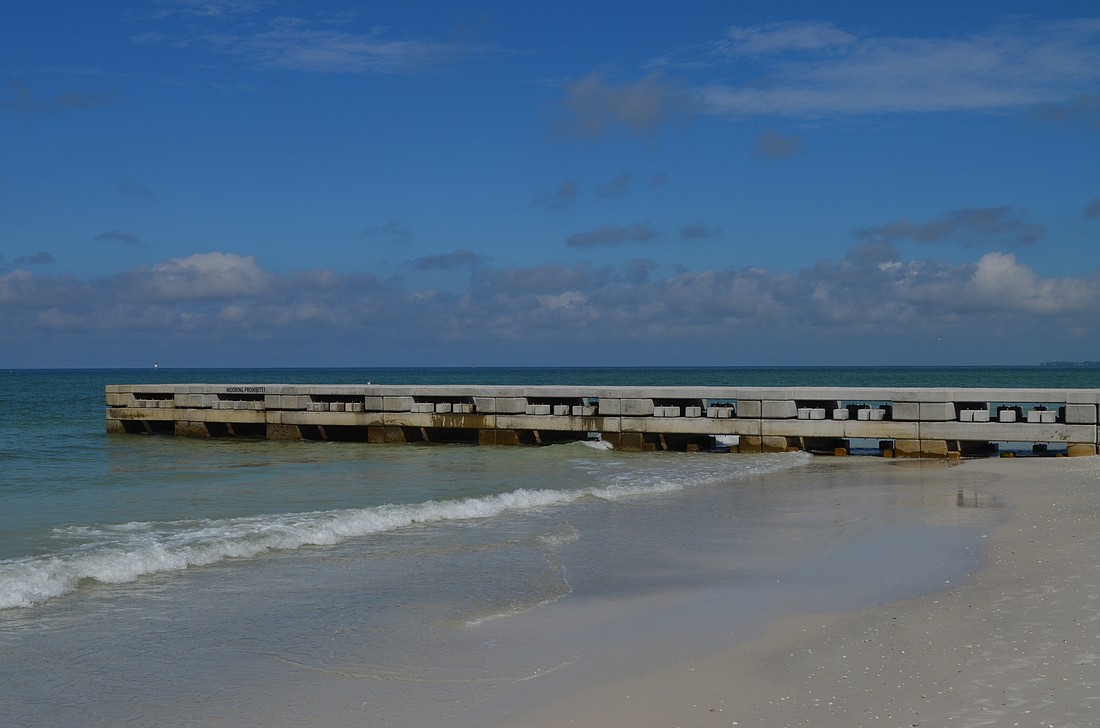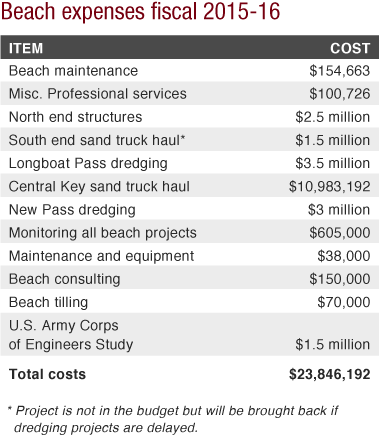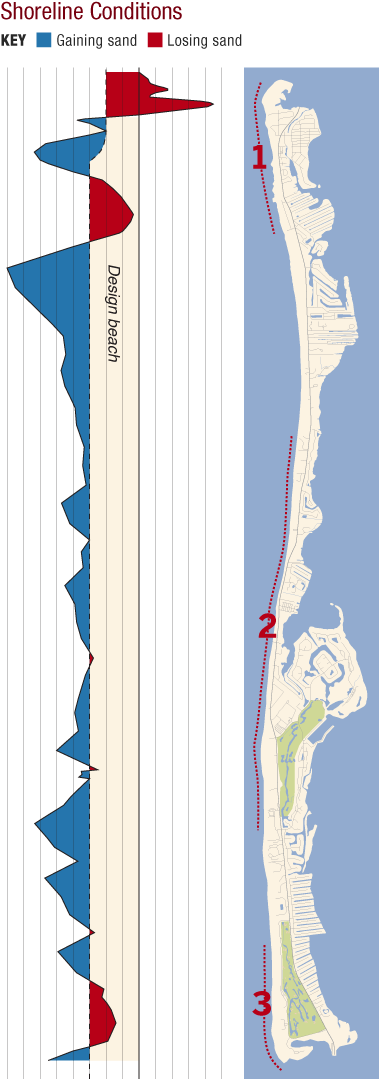- April 18, 2024
-
-
Loading

Loading

The currents are so volatile and the state of the shoreline is so fragile at the north end of Longboat Key, that six out of seven town commissioners don’t want to adjust just yet the sand flow underneath two groins constructed there to hold sand.
Commissioner Phill Younger urged town staff, commissioners and beach engineer Al Browder of Jacksonville-based Olsen Associates Inc. to consider adjusting the groins just a couple of months after their $2 million installation just north of North Shore Road.
Younger argued the shoreline near the North Shore Road beach access has lost about 5,000 cubic yards of sand that was placed in and around groins built to stop the rapid flow of island sand from shifting into Longboat Pass.
Younger blames the loss of sand on an engineering shortfall. The town staff says the loss of sand can be attributed to two stormy months from Mother Nature. Staff said it also has been taking a wait-and-see approach to the groins to determine how the shoreline adjusts to the structures.

At low tide, though, Younger says concrete teeth, or baffling, used to help stop the flow of sand to hold a beach, are non-existent now in the seaward sections of the groins that jut into the Gulf.
He also said the groins have fewer baffles in them than two other groins did when they were constructed behind The Islander Club in 2010.
“My concern is these groins have far fewer baffles in them than the Islander groins after they were adjusted and far fewer baffles than Islander groins when they were originally built,” said Younger at Monday’s workshop.
“We’ve lost a lot of sand there rapidly,” Younger added. “We should adjust them to the same level when we built the Islander groins. They aren’t performing or serving their intended purpose to hold sand.”
The town spent $28,000 to adjust the flow of sand in the Islander groins in 2012 after engineers determined the shoreline to the south of the groins was being starved of too much sand. Younger suggested the town shouldn’t have to pay that cost.
But Browder urged the commission and staff to hold off on adjusting the groins. He said they were adjusted differently than the groins at the Islander Club because the sand flow on the north end of the Key drifts from south to north and sometimes shifts in the other direction in the swirling currents near Longboat Pass.
“There’s a lot of sand still remaining out here in this system,” Browder said. “If we tighten the groins up now and hold too much sand, then we’ll have to come back out and adjust them again. Right now, I wouldn’t do anything but keep track of it and keep taking pictures.”
Commissioner Pat Zunz also noted that conditions on the north end are much different than near the shoreline at the Islander Club.
“My concern is we’re jumping around too early and need to give these (groins) some time,” Zunz said.
Asked by Mayor Jack Duncan for his assessment of the groins so far, Town Manager Dave Bullock said, “They are operating generally as we expected this early.”
“Commissioner Younger may be right,” Bullock said. “But time will tell on this, and we need to monitor the shoreline closely there.”
Younger believes if the groins aren’t adjusted before a Longboat Pass dredging project dumps more sand in the area, the sand, along with some of the $3.5 million the town will pay for that sand project, will wind up right back in the pass.
Younger asked for a consensus vote to instruct the town to request coastal engineering firm Coastal Planning & Engineering to put the number of baffles equal to the number built when the Islander Club groins were built. Younger was the only one who raised his hand.
“At the end of the day, I’m inclined we see what happens over the next six months and monitor this investment on a routine basis,” Duncan said.
Public Works Director Juan Florensa said another shoreline survey for the Key will be performed in May to compare sand losses there.
But commissioners made it clear they don’t anticipate waiting that long to get an update on the progress of the new groins.
“I don’t want to be sitting here after sand from a dredging comes in and be told it all washed through the groins,” Duncan said.
“Before one grain of sand from the dredging goes in,” he said, “we ought to reassess this and make sure the issue of the baffling is addressed.”
Town Manager Dave Bullock started an update on the town’s shoreline at Monday’s regular workshop by proclaiming “2016 is a busy year for beaches.”
For fiscal year 2015-16 alone, it’s also an expensive year for beach projects. Three beach projects and the associated costs that come along with them will bring approximately 600,000 cubic yards of sand to the island’s shore over the next year that will cost town taxpayers approximately $23 million (see sidebar).
Below is an update of three major beach projects that will start soon on Longboat Key:

Longboat Pass Dredging Project
Project: A $3.5 million dredging project of Longboat Pass will fill in eroded areas of the north end with approximately 200,000 cubic yards of sand from Gulfside Road to the North Shore Road beach access.
Start date update: Early 2016 once a federal permit is received.
Mid-Key Beach Project
Project: Longboat Pass and New Pass don’t have enough sand to fill in eroded areas of the shoreline in the center of the Key, which means the priciest part of three-tiered beach project beach project comes with a $10,983,192 dump truck sand haul project.
Start date update: Dump trucks will bring approximately 250,000 cubic yards of sand from a sand source in the middle of the state in April once traffic subsides and the snowbirds leave.
South End Beach Project
Project: A dredging of New Pass will bring 200,000 cubic yards of sand to the south end of the Key to fill in a severely eroded shoreline behind L’Ambiance and neighboring Islandside condominiums that include The Pierre, Longboat Key Towers, The Sanctuary and The Privateer.
Start date update: Early 2016 once a federal permit is received. The town is hopeful it can perform both the Longboat Pass and New Pass projects back to back to minimize dredge mobilization costs.